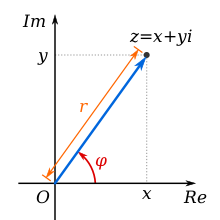
Back عمدة عدد مركب Arabic Argument (anàlisi complexa) Catalan Argumento (análisis complejo) Spanish Argumentu (analisi konplexua) Basque آرگومان (آنالیز مختلط) Persian Argument d'un nombre complexe French Argóint (uimhir choimpléascach) Irish Argumento Galician ארגומנט (אנליזה מרוכבת) HE 複素数の偏角 Japanese

In mathematics (particularly in complex analysis), the argument of a complex number z, denoted arg(z), is the angle between the positive real axis and the line joining the origin and z, represented as a point in the complex plane, shown as in Figure 1. By convention the positive real axis is drawn pointing rightward, the positive imaginary axis is drawn pointing upward, and complex numbers with positive real part are considered to have an anticlockwise argument with positive sign.
When any real-valued angle is considered, the argument is a multivalued function operating on the nonzero complex numbers. The principal value of this function is single-valued, typically chosen to be the unique value of the argument that lies within the interval (−π, π].[1][2] In this article the multi-valued function will be denoted arg(z) and its principal value will be denoted Arg(z), but in some sources the capitalization of these symbols is exchanged.
- ^ Weisstein, Eric W. "Complex Argument". mathworld.wolfram.com. Retrieved 2020-08-31.
- ^ "Pure Maths". internal.ncl.ac.uk. Retrieved 2020-08-31.
